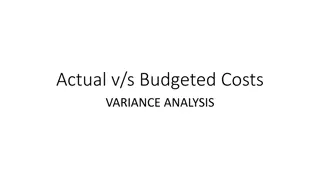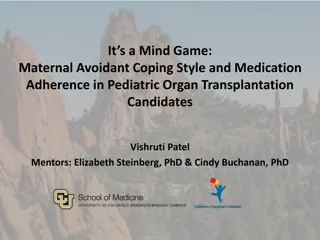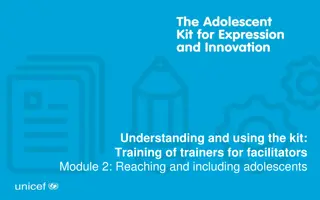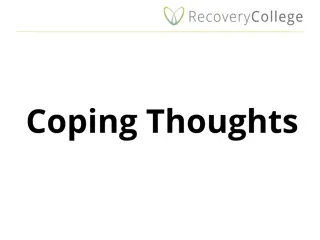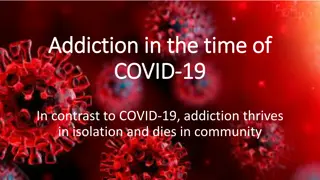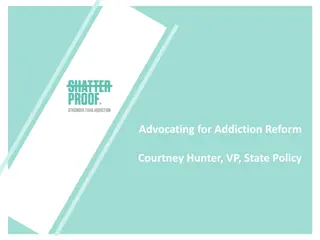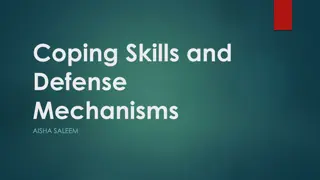Coping Behavior Variances in Adolescents with Varying Degrees of Internet Addiction
Adolescence is a critical period for personal development where coping behavior plays a significant role. This study by Irina Petrochenko focuses on exploring coping behavior features in adolescents with different levels of internet addiction. Research methods involved testing 75 individuals aged 14 to 16 using various questionnaires and scales. Results indicate a positive correlation between certain coping strategies and internet addiction levels. Further analysis compares different methodologies for assessing internet addiction levels. Understanding these coping behavior peculiarities can aid in interventions for adolescents facing internet addiction challenges.
Download Presentation

Please find below an Image/Link to download the presentation.
The content on the website is provided AS IS for your information and personal use only. It may not be sold, licensed, or shared on other websites without obtaining consent from the author. Download presentation by click this link. If you encounter any issues during the download, it is possible that the publisher has removed the file from their server.
E N D
Presentation Transcript
PECULIARITIES OF COPING BEHAVIOUR IN ADOLESCENTS WITH DIFFERENT EXTENT OF INTERNET ADDICTION Irina Petrochenko 1st year postgraduate student at the Faculty of Psychology, National Research Tomsk State University
Adolescence is one of the critical stages in mans personal development, therefore this age group is more susceptible to stress because of the low ability to cope with challenging circumstances. The main purpose of coping behaviour is to restore the emotional balance and the relationship between the individual and the environment, as well as to reduce the associated psychological discomfort. Coping strategies are actions of the individual aimed at overcoming problematic situations. Each coping strategy has modality (cognitive, emotional, behavioral), intensity level (active or passive), and direction of the individual's actions in relation to the situation (adaptive or maladaptive). RELEVANCE 2
The aim of the study is to explore the features of coping behaviour in adolescents with differing levels of Internet addiction, by examining and describing the individual psychological features of coping behaviour. PURPOSE OF THE RESEARCH 3
RESEARCH METHODS AND SAMPLING The research sample comprised 75 persons aged from 14 to 16. The following testing methods were used in the study: E. Heim s Coping Behaviour Questionnaire; Ways of Coping Questionary by S. Folkman and R. Lazarus adapted by T. L. Kryukova; Screening Diagnostics of Computer Addiction by L. N. Yurieva and T. Yu. Bolbot; S. Chen s Internet Addiction Scale. The following methods of mathematical statistics were used: frequency response analysis; cross tables; coefficient analysis (Spearman rank correlation coefficient). 4
BASIC RESULTS Table 1. Results of correlation analysis between coping strategies of S. Folkman, R. Lazarus and level of Internet addiction Level of Internet addiction according to the methodology of L. N. Yurieva and T. Y. Bolbot Propensity for Internet addiction on the S. Cheng Scale Strategies Confrontation ,406** ,331** Distancing ,278* ,323** Escape Avoidance ,365** ,386** N o t e r m a t i o n s ** Correlation is significant at the 0.01 level (two-way) *Correlation is significant at the 0.05 level (two-way) First, Confrontation , Distancing and Escape Avoidance strategies proved to positively correlate with the level of Internet addiction. 5
BASIC RESULTS Table 3. Table of concordance for levels of Internet addiction according to S. Chen's methodology and the Coping Behaviour Study methodology of E. Heim. Table 2. Table of concordance for levels of Internet addiction according to the methodology of L.N. Yurieva, T.Y. Bolbot, and the Coping Strategies methodology of E. Haim. Cognitive coping strategies Relatively adaptive Quantity 1 % of the total 1,6% 7,9% Emotional coping strategies Adaptive Relatively adaptive Quantity 6 % of the total 9,5% Behavioural coping strategies Adaptive Relatively adaptive Quantity 0 % of the total 0,0% Cognitive coping strategies Relatively adaptive 11 17,5% Emotional coping strategies Relatively adaptive 2 14,3% Behavioural coping strategies Relatively adaptive 0 0,0% 17,5% Total Level of Internet addiction Total Level of Internet addiction Adaptive Non-adaptive Adaptive Non-adaptive Quantity % of the total 3 4 18 5 2 8 4,8% 6,3% 28,6% 3,2% 12,7% Non-adaptive Adaptive Non-adaptive 2 3,2% 7 Quantity % of the total 9 18 0 8 No risk of addiction No addiction 11,1% 3,2% 28,6% 0,0% 12,7% Non-adaptive Non-adaptive 1 1,6% Adaptive 7 8 7 Quantity % of the total 11 18 11,1% 12,7% 11,1% 28,6% Second, adolescents with no Internet addiction tend to use for the most part relatively adaptive cognitive and behavioural coping strategies as well as adaptive emotional coping strategies 6
BASIC RESULTS Table 5. Table of concordance for levels of Internet addiction according to S. Chen's methodology and the Coping Behaviour Study methodology of E. Heim. Table 4. Table of concordance for levels of Internet addiction according to the methodology of L.N. Yurieva, T.Y. Bolbot, and the Coping Strategies methodology of E. Haim. Cognitive coping strategies Relatively adaptive Quantity 2 % of the total 3,2% 25,4% Cognitive coping strategies Relatively adaptive 24 38,1% Emotional coping strategies Relatively adaptive 2 3,2% Behavioural coping strategies Relatively adaptive 20 0,0% 31,7% Total Level of Internet addiction Level of Internet addiction Total Adaptive Non-adaptive Adaptive Non-adaptive 16 4 22 Quantity % of the total 0 6 30 6,3% 0,0% 9,5% 47,6% 34,9% Emotional coping strategies Relatively adaptive 3 4,8% Behavioural coping strategies Relatively adaptive 12 19,0% Non-adaptive 9 14,3% Adaptive 10 15,9% Non-adaptive Adaptive Stage of strong involvement A tendency to become dependent Quantity % of the total 22 9 Quantity % of the total 19 30 34,9% 14,3% 30,2% 47,6% Non-adaptive 10 15,9% Adaptive 0 0,0% Non-adaptive Adaptive Quantity % of the total 22 10 Quantity % of the total 0 30 34,9% 15,9% 47,6% Adolescents with obvious passion for Internet and tendency towards addiction most often use relatively adaptive cognitive and behavioural coping strategies as well as adaptive emotional coping strategies. 7
BASIC RESULTS Table 7. Table of concordance for levels of Internet addiction according to S. Chen's methodology and the Coping Behaviour Study methodology of E. Heim. Table 6. Table of concordance for levels of Internet addiction according to the methodology of L.N. Yurieva, T.Y. Bolbot, and the Coping Strategies methodology of E. Haim. Cognitive coping strategies Relatively adaptive 24 38,1% Cognitive coping strategies Relatively adaptive 10 15,9% Emotional coping strategies Relatively adaptive 2 3,2% Behavioural coping strategies Relatively adaptive 11 1,6% 17,5% Total Level of Internet addiction Level of Internet addiction Total Adaptive Non-adaptive Adaptive Non-adaptive 0 8 Quantity % of the total 32 Quantity % of the total 0 5 15 0,0% 12,7% 0,0% 7,9% 23,8% 50,8% Emotional coping strategies Relatively adaptive 3 4,8% Behavioural coping strategies Relatively adaptive 22 34,9% Non-adaptive Adaptive Non-adaptive 15 23,8% Adaptive 14 22,2% Quantity % of the total 32 Addiction stage Existence of an addiction 10 Quantity % of the total 3 15 50,8% 15,9% 4,8% 23,8% Non-adaptive 9 14,3% Adaptive 1 1,6% Non-adaptive Adaptive Quantity % of the total 32 10 Quantity % of the total 1 15 50,8% 4,8% 23,8% Meanwhile adolescents with actual addiction also use relative adaptive cognitive and behavioural coping strategies, though accompanied by maladaptive emotional coping strategies. 8
Thus, the increasing level of Internet addiction correlates with the growing frequency of non-adaptive coping strategies. Adolescents withdrawal to virtual space as one of the ways to cope with stressful situation affects their emotional level to a great extent. The consideration of peculiarities of adolescents coping behaviour will make it possible to individualise psychological prevention programmes and those aimed at correction of Internet addiction CONCLUSION 9









